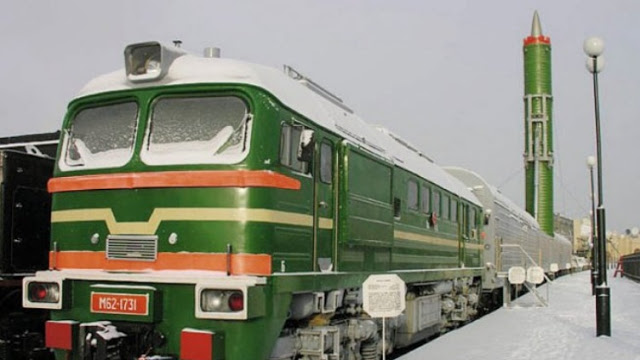It was not a full test, but just a trial of the ‘cold launch’ system, in which the DF-41 was ejected from its launch tube with a gas charge but the engine was not ignited. As such it was likely meant to test the tube launch system’s compatibility with its new rail car. This followed an apparent full flight test of the DF-41 on 4 December 2015.
Details of both tests were first revealed by US officials to The Washington Free Beacon , which reported on the latest test on 21 December 2015.
This also confirms previous reports of China’s interest in rail mobility to increase the survivability of its ICBM force. In a May 2012 journal article the former chief of staff of the Russian Strategic Rocket Forces, retired Colonel General Victor Esin, noted there would be a rail-mobile version of the DF-41.
In 2013 the Georgetown University Arms Control Project reported that China had obtained ICBM rail car insights from Ukraine, where the Yuzhnoye Design Bureau produced the RT-23 (SS-24 ‘Scalpel’) rail-mobile solid-fuel ICBM used by the Soviet Union and then Russia from 1987 to 2005.
The first version of the 14,000 km-range, 10-warhead-capable DF-41 is carried by an 18-wheel transporter-erector-launcher (TEL).
Russia’s second-generation rail-based ICBM system, called Barguzin, could enter service in 2020. One train, or a regiment, could carry up to six ICBMs.
An image of an RT-23 (SS-24) missile train could give some indication of the configuration of China’s rail-mobile DF-41. Source: Russian Internet
Little is known about the structure of China’s rail-mobile DF-41 units, although they are expected to exploit China’s rail tunnels. Taiwanese sources have reported that China has already constructed 1,000 to 2,000 km of special rail to accommodate these heavy ICBMs.
The “Barguzin” complex will remain in service at least before 2040. The starting weight of a new missile will not exceed 47 tonnes. The missile that will be developed on the basis of the Yars ICBM will be housed in a standard rail car. The new complex will look like a normal train with passenger and freight cars, in which all the necessary equipment will be installed.
The missiles that were used for “Molodets” complexes weighed more than 100 tons each. The cars with the launcher thus had to be equipped with special technology to distribute the weight load on nearby cars, which was, of course, problematic. The use of much lighter missile will cast all those problems aside.
As previously reported, the main element of the complex – the missile – will be developed on the basis of the Yars ICBM. The railway complex will be similar to the ground-based Yars, albeit with many missiles. If we take, for example, a 15-car train with five technical cars, Barguzin’s one salvo will consist of ten missiles. A rail complex would be much cheaper than Borei submarines, even though a submarine of this class carries 16 missiles.
Today, the RS-24 Yars has three stages with the total length of about 23 meters. The starting weight is estimated at 45-49 tons. The maximum range – 11,000 km. Details of combat equipment are not available.

Brian Wang is a Futurist Thought Leader and a popular Science blogger with 1 million readers per month. His blog Nextbigfuture.com is ranked #1 Science News Blog. It covers many disruptive technology and trends including Space, Robotics, Artificial Intelligence, Medicine, Anti-aging Biotechnology, and Nanotechnology.
Known for identifying cutting edge technologies, he is currently a Co-Founder of a startup and fundraiser for high potential early-stage companies. He is the Head of Research for Allocations for deep technology investments and an Angel Investor at Space Angels.
A frequent speaker at corporations, he has been a TEDx speaker, a Singularity University speaker and guest at numerous interviews for radio and podcasts. He is open to public speaking and advising engagements.


